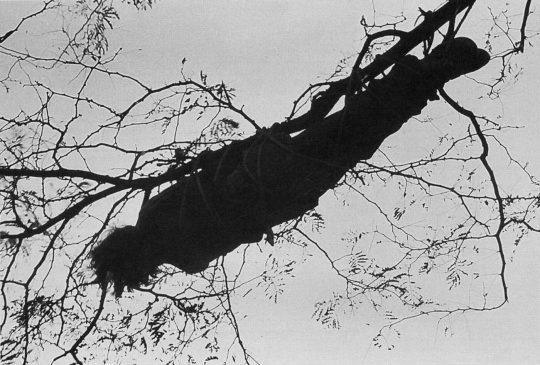#Charles Ray
Explore tagged Tumblr posts
Text

Charles Ray: Untitled (1973)
2K notes
·
View notes
Photo

Charles Ray, Untitled, 1973, black and white photograph, 27 × 40 inches inches. Courtesy of Feature.
4K notes
·
View notes
Text


by Charles Ray
source: collectionarchive.tumblr.com
44 notes
·
View notes
Text


Charles Ray (US, 1953)
Plank Piece I and II 1973. Two gelatin silver prints, printed 1992
The slanted board recalls artist John McCracken’s “planks” of the 1960s. By including his body as an element within the work, Ray approaches sculpture not as a static object but as an activity. The work is humorous and disarming, yet also decidedly devoted to sculptural principles. Ray studies the forces of weight, gravity, and the intrinsic ability of the plank to support his mass without breaking.
https://www.moma.org/collection/works/46150
https://www.thebroad.org/art/charles-ray/plank-piece-i-ii
58 notes
·
View notes
Text

#halloween special#couldtheyescortelliewilliams#Chucky#child’s play#charles lee ray#charles ray#chucky movies#chucky franchise#slashers#the last of us#ellie williams#joel miller#tlou#character polls#fandom polls#polls#tumblr polls#tlou poll#hbo the last of us
5 notes
·
View notes
Text
an longtime favorite of mine

“Some critics have read Ray’s gesture in Plank Piece as a similar comment on the dominance of minimalism in the 1960s (see, for example, Nittive and Ferguson 1994, p.17). As the geometric form pins the artist to the wall, physical restriction comes to represent aesthetic restraint. In this reading Plank Piece acts as a bodily intervention in minimalism.”
14 notes
·
View notes
Text

Charles Ray Future Fragment on a Solid Base, 2011 Solid aluminum 82¾ × 48 × 36 in
9 notes
·
View notes
Text

Charles Ray
A copy of ten marble fragments of the Great Eleusinian Relief (2017), machined aluminum
23 notes
·
View notes
Text

Corinne Griffith and Charles Ray on a vintage postcard
#carte postale#postkarte#historic#postcard#sepia#ansichtskarte#postkaart#tarjeta#charles ray#griffith#briefkaart#ephemera#photography#charles#corinne#vintage#postal#corinne griffith#photo
9 notes
·
View notes
Text
New profile pic is Boy by Charles Ray (1992) at the Art Institute of Chicago.
4 notes
·
View notes
Text

Charles Ray-Colleen Moore "The busher" 1919, de Jerome Storm.
4 notes
·
View notes
Text


"If ghosts existed, would they haunt the actual substance of a place or object? Or would the object’s topology, geometry, or shape be enough to hold the ghost? Unpainted Sculpture began as an investigation into the nature of a haunting. I studied many automobiles that were involved in fatal collisions. Eventually I chose a car that I felt held the presence of its dead driver."
Charles Ray made Unpainted Sculpture in 1997, a monochrome light grey (primer) replica in fiberglass of a wrecked Pontiac Grand Am. It's in the collection of the Walker Art Center in Minneapolis, but it's his thing about ghosts that reminded me of it.
#charles ray#ghosts#walker art center#fiberglass#rip#does the possibility of someone walking into the walker some day and be like holy smokes that's the car my dad was driving haunt you?
14 notes
·
View notes
Text


Charles Ray (US, 1953)
Boy with frog, 2009. Painted stainless steel 2,43 m. Photograph by Robertz
[monumental size, yet minimal respect to "inferior" otherness]
https://andreasworldstage.com/charles-ray-retrospektive-am-met/
https://www.vulture.com/2013/05/saltz-venice-is-losing-a-great-artwork.html
https://www.ft.com/content/60354f52-3036-43a5-9905-5743d2eca640
18 notes
·
View notes
Text
instagram
Charles Ray
9 notes
·
View notes

